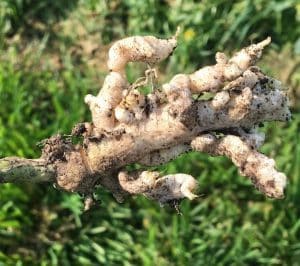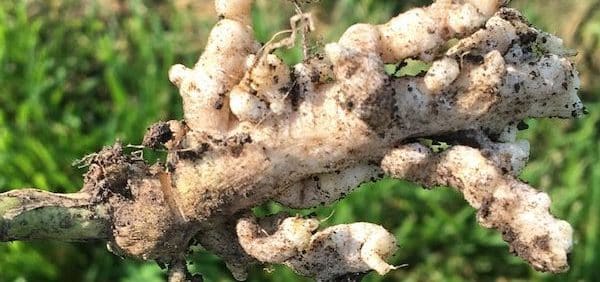This article runs through a series of questions and scenarios, a bit like “choose your own adventure”, to help farmers and agronomists come up with an appropriate management plan for each situation.
1. Are you growing a susceptible canola cultivar?
If no…go to 5
If yes…
- Consider an extended break from canola and use resistant varieties going forward. Keep in mind, the resistant varieties also need to be scouted closely for a shift of pathotypes. (See more on pathotype testing below.) Go to 2.

2. Is clubroot only found at the field entrance?
If no…go to 5
If yes…
- If the area is small enough, billions of spores can be removed from the field by extracting the roots/galls from the soil, bagging the roots and galls like you would a noxious weed, and disposing of them in a landfill. Incineration at high heat can destroy most of the spores, but achieving enough fire intensity to completely destroy wet root tissue can be difficult. If burning galls, make sure to dispose of the ashes (containing spores still potentially viable) at the landfill or a place where the remnants can’t be moved around.
- Grassing the entrance will keep the soil from moving around, provide a place to clean equipment, and potentially increase the speed at which spores disappear.
- Creating a new field exit far away from the infested area will reduce the chances of transferring contaminated soil to other fields.
- The use of resistant varieties is essential on the farm.
3. Is clubroot only in a few small patches?
If no…go to 4
If yes…
- If the area is small enough, billions of spores can be removed from the field by extracting the roots/galls from the soil and disposing of them at the landfill. Burning can be difficult; make sure you dispose of the ashes (containing spores still potentially viable) at the landfill or a place where the remnants can’t be moved around.
- Grassing these patches (water runs/entrances/low area/etc.) will keep the soil from moving around and potentially increase the speed at which spores disappear.
- An extended break from canola (minimum two years without canola) will help reduce spore loads to manageable levels.
- The use of resistant varieties is essential on the farm.
- Soil testing in the same spot consistently can determine how many spores per gram of soil are in these patches and how the number changes over time. Tracking spore loads can help with management and rotational decisions.
4. Is clubroot all over the place in the field?
If no…follow management steps 2 and 3.
If yes…
This requires significant management. Refer to clubroot.ca for further reading and a better understanding how to manage clubroot. As a summary, here are the top five things that need to be considered:
- An extended break from canola. (Two to three years will not be long enough to bring spore levels to more manageable levels.)
- Use resistant hybrids and closely monitor for clubroot. Scout as if the variety doesn’t have resistance.
- Clean equipment before leaving the field and minimize tillage/soil movement within the field.
- Control volunteer canola and other susceptible weeds.
- Use patch management in the highest risk area. Patch management includes grassing and/or liming.
5. A resistant hybrid has clubroot. Is the clubroot in patches or randomly scattered?
If patches… go to 6
If individually-infected plants are randomly scattered…
- These could be volunteers. Check if they are found outside the seed row, which suggests it’s a volunteer. Sometimes a blue seed coat, indicating a planted seed, can be seen if plants are carefully removed from the soil.
- Plants that don’t carry the resistant gene for a variety of reasons could also result in randomly scattered plants infected with clubroot. This should be less than 10 per cent of plants, often less than five per cent.
- If in doubt, send samples to an accredited lab for clubroot confirmation.
6. Is clubroot only in a few small patches?
If no…go to 7
If yes…
- If the area is small enough, billions of spores can be removed from the field by extracting the roots/galls from the soil and disposing of them at the landfill. Burning can be difficult; make sure you dispose of the ashes (containing spores still potentially viable) at the landfill or a place where the remnants can’t be moved around.
- Grassing these patches (water runs/entrances/low area/etc.) will keep the soil from moving around and potentially increase the speed at which spores disappear
- An extended break from canola should be considered to preserve the sustainability of resistant sources.
- Take samples for pathotyping and begin to understand genetics and clubroot resistance to make decisions on variety selection going forward. If you’d like to collect samples for pathotyping, please contact a CCC agronomy specialist.
- Consider new sources of clubroot resistance.
7. Is clubroot found in significant areas while growing a resistant variety?
If yes…
- Consider an extended break from canola, allowing the spore load to decline to manageable levels.
- Avoid soil movement within the field by using minimal/zero tillage practices.
- Avoid soil movement out of the field by practicing sanitation and equipment cleaning.
- Consider grassing the field for a couple of years until spore loads decline.
- Consider soil testing in consistent locations (ex. marked by GPS) to monitor the level of spores over time and resume growing canola when spore loads reach desired levels.
- Send in samples for pathotyping. For information on how to collect samples and where to send them, please contact a CCC agronomy specialist.
- When growing canola, use a hybrid with resistance to the predominant pathotype identified from the samples sent. Otherwise choose varieties with a different source of resistance going forward.
